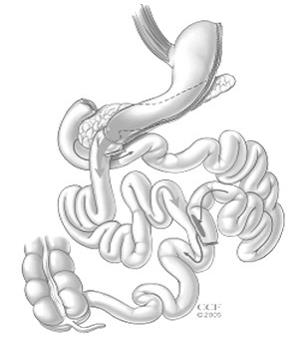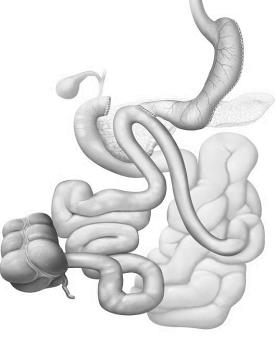SINGLE ANASTOMOSIS DUODENO-ILEOSTOMY WITH SLEEVE (SADI-S)
CONVENIENTLY LOCATED TO SERVE RALEIGH, NC
Single Anastomosis Duodeno-ileostomy with Sleeve (SADI-S), also known as SADI-S is the newest weight loss procedure. SADI-S is a modification of the traditional duodenal switch (DS), bypassing less of the intestines. The procedure combines a sleeved stomach and attaches a medium-length bypass. Weight loss is 75% of excess weight and the absorption of vitamins and protein after surgery improved.
Single Anastomosis Duodeno-ileostomy with Sleeve can be compared to a Duodenal Switch procedure, but SADI-S only has a single connection with the small intestine. Since it involves a longer common channel, this reduces the risk of malabsorption.
SADI-S lessens the appetite and the small intestine’s ability to absorb calories. It also improves metabolic hormones and health conditions.
Ideal Candidates
The best candidates for Single Anastomosis Duodeno-ileostomy with Sleeve are those battling morbid obesity. It is ideal for those who want a better weight-loss method than a gastric bypass and sleeve.
Among its benefits are better long-term weight loss, diabetes treatment, lower chance of weight regain, less acid reflux, and reduced risk of stomach ulcer than those provided by bypass and sleeve.
Single Anastomosis Duodeno-Ileostomy with Sleeve Consultation
At your consultation with our bariatric specialists, you may need to bring imaging or lab results required by our doctors to gauge suitability for the procedure. You also need to be mentally prepared before deciding to go through with the surgery or not.
The consultation is meant to prepare you for your responsibilities after the SADI-S, including post-surgery care and lifestyle changes. Don’t hesitate to ask questions or discuss your concerns about the surgery.
The Procedure
First, the bariatric specialist will perform a sleeve gastrectomy, removing a large part of the stomach and modifying the shape of the remaining part. The doctor then separates the duodenum from the pylorus before the ileum is connected to the duodenum.
SADI-S distinguishes itself from other duodenal switch procedures because it only involves one anastomosis instead of the usual two. It directs nutrients through a single loop, which reduces the chance of vitamin deficiency and diarrhea.
The Recovery Process
You only need to spend an hour on the table while the specialist performs the Single Anastomosis Duodeno-ileostomy with Sleeve. Patients often only need a night or two at the hospital. They can return to their regular routines after 2-4 weeks.

Traditional Duodenal Switch

Single Anastomosis Duodeno-ileostomy with Sleeve (SADI-S)
The Cost of Single Anastomosis Duodeno-ileostomy with Sleeve
Insurance coverage of the SADI-S procedure in our area is limited, but this procedure is a self-pay option that we perform at an outpatient surgery center at a reduced price. The exact cost may vary depending on the details of the procedure.
Contact Us to Learn More
If you are interested in learning more about Single Anastomosis Duodeno-ileostomy with Sleeve (SADI-S) in Raleigh, arrange a consultation by contacting our office. During your visit, our bariatric surgeons can discuss best practices for preparation, recovery, and more.
REX Bariatric Specialists serves all of North Carolina, providing specialty care in weight loss surgery. Our office locations include Raleigh, Wake Forest, Garner, and Cary. We reach patients throughout the region by telemedicine, from Wilmington, Greenville, Charlotte, and beyond as a destination center for bariatric surgery.
FAQs
The primary distinction lies in the complexity and extent of the intestinal rearrangement. Traditional DS involves two major surgical components: a sleeve gastrectomy and an extensive rerouting of the intestines, creating two separate pathways (alimentary and biliopancreatic) that meet in a common channel. In contrast, SADI-S simplifies this by performing a sleeve gastrectomy followed by a single anastomosis or connection between the end of the ileum and the duodenum, thus eliminating the need for a separate biliopancreatic diversion.
Both procedures offer substantial weight loss and improvement in obesity-related comorbidities. However, SADI-S is often associated with a lower risk of nutritional deficiencies compared to traditional DS, due to the less extensive intestinal bypass. Studies suggest that SADI-S may also have a slightly lower complication rate, given the simplicity of the procedure.
Patients undergoing either surgery must commit to lifelong dietary modifications, vitamin supplementation, and regular follow-up care. However, the SADI-S procedure might require less aggressive supplementation due to its lower risk of malabsorption. Regular monitoring is essential to adjust supplementation as needed and to ensure optimal health and weight loss outcomes.
After undergoing SADI-S surgery, patients can typically expect a hospital stay of about 2 to 3 days. This duration is necessary to ensure proper recovery and to monitor for any immediate post-operative complications.
Discharge criteria typically include the ability to tolerate liquid diets, adequate pain control with oral medications, and the absence of surgical complications. Post-discharge, patients are advised to follow up closely with their surgical team to monitor their recovery process and to adjust their dietary and medication regimens as needed.
Post-SADI-S surgery, it is crucial to be aware of signs that may indicate complications. Early detection and treatment can prevent more severe issues. Seek prompt medical attention for any of the following symptoms:
- Persistent Nausea or Vomiting: While some nausea is expected post-surgery, persistent or severe vomiting may indicate a blockage or other complications.
- Severe Abdominal Pain: Any sudden or severe abdominal pain should be evaluated immediately, as it could signal internal bleeding, perforation, or other serious conditions.
- Fever and Chills: These symptoms could indicate an infection, particularly if accompanied by redness, discharge, or swelling at the incision sites.
- Inability to Tolerate Liquids or Food: Difficulty in swallowing or keeping food down might suggest a stricture or obstruction in the digestive tract.
- Unusual Swelling or Redness: Particularly around the surgical site, this could be a sign of infection or herniation.
- Changes in Bowel Movements: Severe diarrhea, constipation, or any noticeable changes in stool color (like dark, tarry stools) should be reported.
- Shortness of Breath or Chest Pain: These symptoms require immediate attention as they could indicate a pulmonary embolism or heart-related issues.
SADI-S surgery can significantly impact the absorption of medications. This effect is primarily due to the reduced surface area for absorption and changes in gastric pH levels. Patients should inform all healthcare providers, including pharmacists, about their surgery. To ensure proper management of medications, the following changes and protocols may be necessary:
Alternative Formulations - Patients may need to switch to liquid, chewable, or sublingual forms of medication to improve absorption.
Dosage Adjustments - Some medications may require dosage adjustments. This might mean higher doses to achieve the same effect or lower doses if the drug's metabolism is slowed.
Monitoring and Adjustments: Regular blood tests to monitor levels of medications, especially for conditions like hypertension, diabetes, and thyroid disorders, are crucial. Based on these tests, doctors can make necessary adjustments to dosages.
Similar to this Procedure
Meet the Doctors who perform this surgery:
Testimonials
Dr. Sharp, Dr. Ng and all of the staff are amazing! I completely trust them with my care. The surgeons are very knowledgeable and they will continue to follow you closely after surgery to make sure you are meeting your goals and healing properly. I really enjoyed the education and dietician classes prior to surgery. It prepared me for a healthier lifestyle in the long run. I highly recommend this practice.



